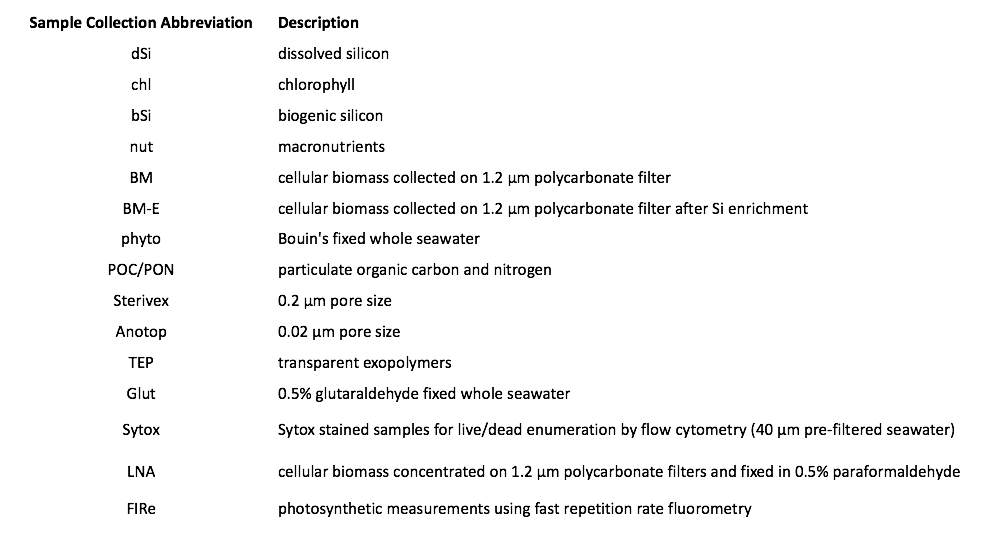Event log from the R/V Oceanus OC1504A, a cruise along the Oregon/California Coastal Upwelling Zone, between 34-44N and 120-124W during 2015
Project
| Contributors | Affiliation | Role |
|---|---|---|
| Thamatrakoln, Kimberlee | Rutgers University (Rutgers IMCS) | Chief Scientist, Contact |
| Brzezinski, Mark A. | University of California-Santa Barbara (UCSB-LifeSci) | Co-Chief Scientist |
| Ake, Hannah | Woods Hole Oceanographic Institution (WHOI BCO-DMO) | BCO-DMO Data Manager |
Abstract
Event log from OCE1504A cruise, Molecular Underpinnings of Silicification in the California Current (MUSiCC). A sample ID key of all samples included in the dataset can be found below:

For related datasets, click on the project link at the top of the page.
The log includes a record of all scientific sampling events from the cruise. In addition to event identification numbers unique for the cruise, the scientific sampling event log includes date and time (UTC), position (latitude and longitude), station and samples collected, activity (CTD cast), bottom depth, and a comment field to record additional information.
DMO Notes:
-Parameter names were converted to lowercase and/or to standard BCO-DMO naming conventions
-removed "consecutive sample number" "latitude (mm.mmm)" "Longitude (dd)" "Latitude (DD)" "Longitude (mm.mmm)" columns. "Consecutive Sample Number" was removed at the request of the Kim Thamatrakoln, PI.
-replaced all "," with ";"
-reformatted all column names, replacing spaces with "_" and changing names to comply with BCO-DMO standards.
-added "nd" to blank fields, and fields with "~" or "?" after clarifying their meaning with PI.
| File |
|---|
event_log.csv (Comma Separated Values (.csv), 4.68 KB) MD5:32f94cf101db09378df565e2e3bc627b Primary data file for dataset ID 651685 |
| Parameter | Description | Units |
| cruise | Cruise name associated with OC1504A. | unitless |
| event | ID number for the event. | unitless |
| activity | Activity performed with the instrument. | unitless |
| date_local | Local date that the event took place; format dd-bbb-yy. | unitless |
| time_local | Local time that the event took place; format HH:MM. | unitless |
| time_utc | Time (UTC) that the event took place; format HH:MM. | unitless |
| date_utc | Date (UTC) that the event took place; format dd-bbb-yy. | unitless |
| station | Alpha-numeric code representing the sampling station. | unitless |
| depth_w | Bottom depth | meters |
| lat | Latitude in decimal degrees. | decimal degrees |
| lon | Longitude in decimal degrees. | decimal degrees |
| samples_collected | Types of samples collected. | unitless |
| comments | Free text comments about the sampling event and post-cruise corrections. | unitless |
OC1504A
| Website | |
| Platform | R/V Oceanus |
| Report | |
| Start Date | 2015-04-19 |
| End Date | 2015-05-02 |
| Description | Data for the project "Linking physiological and molecular aspects of diatom silicification in field populations" (PIs Kimberlee Thamatrakoln and Mark Brzezinski) were collected on this cruise. |
Linking physiological and molecular aspects of diatom silicification in field populations (Diatom Silicification)
Description from NSF award abstract:
Diatoms, unicellular, eukaryotic photoautotrophs, are among the most ecologically successful and functionally diverse organisms in the ocean. In addition to contributing one-fifth of total global primary productivity, diatoms are also the largest group of silicifying organisms in the ocean. Thus, diatoms form a critical link between the carbon and silicon (Si) cycles. The goal of this project is to understand the molecular regulation of silicification processes in natural diatom populations to better understand the processes controlling diatom productivity in the sea. Through culture studies and two research cruises, this research will couple classical measurements of silicon uptake and silica production with molecular and biochemical analyses of Silicification-Related Gene (SiRG) and protein expression. The proposed cruise track off the West Coast of the US will target gradients in Si and iron (Fe) concentrations with the following goals: 1) Characterize the expression pattern of SiRGs, 2) Correlate SiRG expression patterns to Si concentrations, silicon uptake kinetics, and silica production rates, 3) Develop a method to normalize uptake kinetics and silica production to SiRG expression levels as a more accurate measure of diatom activity and growth, 4) Characterize the diel periodicity of silica production and SiRG expression.
It is estimated that diatoms process 240 Teramoles of biogenic silica each year and that each molecule of silicon is cycled through a diatom 39 times before being exported to the deep ocean. Decades of oceanographic and field research have provided detailed insight into the dynamics of silicon uptake and silica production in natural populations, but a molecular understanding of the factors that influence silicification processes is required for further understanding the regulation of silicon and carbon fluxes in the ocean. Characterizing the genetic potential for silicification will provide new information on the factors that regulate the distribution of diatoms and influence in situ rates of silicon uptake and silica production. This research is expected to provide significant information about the molecular regulation of silicification in natural populations and the physiological basis of Si limitation in the sea.
| Funding Source | Award |
|---|---|
| NSF Division of Ocean Sciences (NSF OCE) | |
| NSF Division of Ocean Sciences (NSF OCE) |
[ table of contents | back to top ]